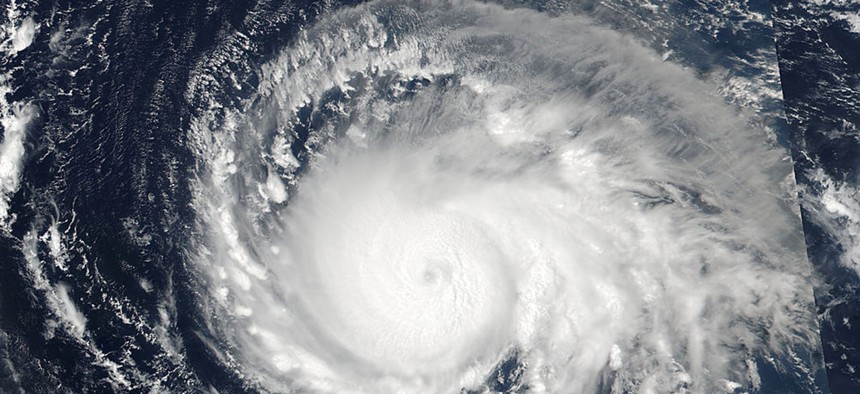NASA's Next Head Wants it to Do Less Climate Science and More Weather Science, But You Can’t Separate Them
Jim Bridenstine would be in charge of an agency critical to both climate science and storm tracking. He's much fonder of the latter.
NASA has a likely new head, and like other people the Donald Trump administration has put in top science-related jobs, he’s not a big fan of climate-change research.
Trump’s NASA nominee is Jim Bridenstine, a congressman from Oklahoma. In 2013, he told Congress that global temperatures “stopped rising 10 years ago” (not true) and that “global temperature changes, when they exist, correlate with sun output and ocean cycles” (there is a small correlation, but plenty of research shows greenhouse gases play a far larger role). Two years ago he needled “climate-change alarmists” on Twitter.
But assuming the Senate confirms his nomination (a formality), Bridenstine will lead a space agency that spends nearly a tenth of its budget on “earth science,” which includes research into both weather patterns and climate change. Trump originally said he wanted to scrapthe earth science program entirely in favor of space exploration, but his proposed 2018 budget took a milder approach, cutting the program by a little under 10%, to $1.8 billion. NASA’s overall budget is $19.6 billion.
Bridenstine evidently knows the importance of weather research. “People often say, ‘Why are you so involved in space issues?'” he reportedly said (paywall) at a commercial space transportation conference this year. “My constituents get killed in tornadoes. I care about space.” In his 2013 speech in Congress, he chided president Barack Obama for spending “30 times as much money on global warming research as he does on weather forecasting and warning.” (That’s false too.)
From this one may infer that Bridenstine believes it’s important to, say, track and study major storms, but less important to investigate why they’re becoming more severe, even though researchers have found over and over that global warming is making phenomena like hurricanes, floods, droughts, heatwaves, and wildfires more devastating than they would have been otherwise.
The trouble is that weather research and climate research are not so simple to disentangle. NASA’s 16 earth science satellites (plus three other instruments attached to the International Space Station) make up the core of the agency’s climate science program. They don’t just collect data on climate change; they also monitor, among other things, the oceans, soil health, wildfires, air quality, and hurricanes. That makes the program useful for emergency response during major, fast-developing storms.
Hurricane #Irma is maintaining it's strength with maximum sustained winds of 185 MPH. The eye is approaching the island of Barbuda. #GOES16 pic.twitter.com/85fHMLVr5H
— NASA SPoRT (@NASA_SPoRT) September 6, 2017
Right now, Hurricane Irma, the second-strongest hurricane ever observed over the Atlantic Ocean, is barreling through the Caribbean en route to Florida—and a team from NASA and the National Oceanographic and Atmospheric Administration is watching its path with the most advanced weather satellite the agencies have ever built. The GOES-16 satellite, launched last year, can take far higher resolution images of the developing storm than any of its predecessors.
Saint-Martin and Anguilla appear to have taken a direct hit by cat 5 Hurricane #Irma. #GOES16 pic.twitter.com/1CN1JL0GEC
— NASA SPoRT (@NASA_SPoRT) September 6, 2017
While Bridenstine’s climate-denying comments from 2013 are sure to come up in his Senate confirmation hearings, a former colleague told told Science magazine that Bridenstine does believe the planet is warming and that carbon dioxide is a greenhouse gas. As for his climate change-denial comments from 2013, he’d “probably say it differently today.” In an editorial, the editor of The Tulsa World said the same thing—that Bridenstine told him he would have phrased it differently now.
But he also told the editor he had opposed the US’s involvement in the Paris climate accord, from which Trump has said the US will withdraw, and that while he does believe carbon dioxide is warming the planet, he would probably disagree “about the severity of the problem” with people who accept the scientific consensus. The editor noted that he doesn’t believe Bridenstine has “moderated much” since his 2013 speech on the House floor.
Columbia University climate law professor Michael Gerrard was more forceful, calling Bridenstine a “climate denier” on Twitter.
Trump's nominee to lead NASA: Rep. Jim Bridenstine, a climate denier like fellow Oklahomans J Inhofe & Scott Pruitt. https://t.co/zN0OyND1lA pic.twitter.com/P4WrHX3PNd
— Michael Gerrard (@MichaelGerrard) September 2, 2017
It’s not yet clear, then, what Bridenstine would do to NASA’s earth sciences program. But any large, immediate cutbacks to the mission would be difficult if not impossible. Ceasing to fly the satellites simply isn’t an option, according to a contractor Quartz spoke with earlier this year, who works as an engineer for one NASA satellite that collects climate data.
“If you stopped operations—if nobody manned the satellites—they would crash and spread space debris,” which would threaten other satellites in orbit and is a danger nobody would risk, the engineer said. Bringing the satellites back to Earth is another option, but the “deorbiting process” takes “years and years,” the engineer says. Plus, most contractors are on a five-year contract, and the sprawling infrastructure and personnel involved in ongoing missions couldn’t just be terminated or shifted to another agency without enormous expense.
Still, while ceasing the earth science program altogether might not be practical, the engineer worried about NASA simply ceasing data collection from the satellites. That would punch a hole in the data used by climate scientists worldwide and jeopardize the scientific rigor of US research.



